Abstract
To solve the disadvantages of the low protection grade, high weight, and high cost of the existing locomotive power battery system, this study optimizes the existing scheme and introduces the design concept of two-stage protection. The purpose of the research is to improve the protection level of the battery pack to IP68, to optimize the sheet metal power battery box structure into a more lightweight frame structure, to simplify the cooling mode of the battery pack for natural air cooling, and to improve the battery protection level and maintain the heat exchange capability. In the course of the study, a design scheme with a two-stage protection function is proposed. The numerical model analyzes the self-load, transverse load, longitudinal load, mode, and fatigue, and optimizes the layout of the power tank cell. The optimized box model was physically tested and economically compared. The results show that: (1) The maximum load stress is 128.4 MPa, which is lower than 235 MPa, the ultimate stress of the box material, and the fatigue factor of the frame box structure is 3.75, which is higher than 1.0, and it is not prone to fatigue damage. (2) Under the low-temperature heating condition, the overall temperature rise of the battery pack is 4.3 °C, which is greater than 2.3 °C under the air conditioning heat dissipation scheme. Under the high-temperature charging condition, the overall temperature rise of the battery pack is 2.0 °C, and the temperature value is the same as the temperature rise under the air conditioning cooling scheme. Under the high-temperature discharge condition, the overall temperature rise of the battery pack is 3.0 °C, and the temperature value is greater than 2.1 °C under the air conditioning heat dissipation scheme. At the same time, the temperature rise under the three working conditions is less than the 15 °C stipulated in the JS175-201805 standard. The simulation results show that the natural airflow and two-stage protection structure can provide a good temperature environment for the power battery to work. (3) The optimized box prototype can effectively maintain the structural integrity of the battery cell in the box in extreme test cases, reducing the probability of battery fire caused by battery cell deformation. (4) The power battery adopts a two-stage protection design under the battery power level, which can simultaneously achieve battery protection and prevent thermal runaway, while reducing costs. The research results provide a new concept for the design of a locomotive power battery system. (5) The weight of the optimized scheme is 2020 kg, and the original scheme is 2470 kg; thus, the reduction in weight is 450 kg. Meanwhile, the volume of the optimized scheme is 1.49 m3, and the original scheme is 1.93 m3; thus, the reduction in volume is 0.44 m3.
1. Introduction
The battery is the electric energy storage unit of locomotive and its vehicles, which is the key component to ensure the start of the diesel engine, auxiliary circuit operation, and locomotive standby power supply. In recent years, the application of new energy equipment in the field of rail transit is on the rise [1]. Batteries have also gradually become a source of power for the rolling stock [2,3,4]. No matter what type of battery, it is necessary to provide adequate protection and a good working storage environment. In recent years, the problem of vehicle battery protection has attracted wide attention in the industry [5,6].
On the one hand, scholars have studied the material and structure of the power battery box. In the study of Yuhang An [7], the power battery boxes of glass fiber, carbon fiber, and carbon steel were modeled and compared by mechanical simulation. The results showed that the carbon fiber material had good performance in providing a light weight power battery box. According to the collision regulations, the collision simulation of the side of the car body was conducted, and the stress, deformation, and lateral acceleration changes of the battery box were analyzed; the effectiveness of improving the safety measures of the battery box was verified by Qiao Weigao [8]. Quanming Ding [9] finished the design and the finite element analysis of the emergency backup power system protective box was conducted; the effects of the burst impact pressure of hydrogen on the box at different concentrations were considered. Changfu Peng [10] proposed the safety design scheme of rail vehicle lithium batteries with active safety protection and passive protection. Xiaohong Zhang [11] took the power battery box of an electric vehicle as the research object, and the design concept of carbon fiber applied to the power battery box was discussed, while the specific design process was expounded. Li J. [12] used a combined simulation of Hypermesh and ANSYS to analyze a power supply battery box in an electric vehicle’s intrinsic mode and the characteristics of the responses caused by random vibration. Chen [13] studied a method of battery box parts’ material replacement from mild steel sheets to aluminum alloy steel sheets, brought forward the changed depth, and selected the appropriate material by using the material index.
On the other hand, scholars have also carried out in-depth research on the cooling mode of the power battery system. Yufa Meng [14] analyzed the power battery group structure of the HXN6 hybrid shunting locomotive and designed a battery system with a one-stage protection structure and air conditioning. In the design of a hybrid shunting locomotive, Bin Liu [15] designed the lithium titanate battery system, which effectively reduced the harmful impact of the high temperature issued by the diesel engine under the normal operation of the battery pack. Jiaying Xie [16] designed the water cooling system for the battery. Lihang Hu [17] concluded that natural air cooling is suitable for application on occasions with small locomotive loads, and that water cooling or air conditioning should be adopted for a large load cycle. Yoshiaki Taguchi et al. [18] have developed a new EMU (electric multiple units train) battery cooling fan, which improves the battery box cooling performance and reduces the maximum operating temperature of the power battery. Yue [19] studied the liquid thermal management system of an electric vehicle power battery, and the outcome showed that the system structure with the interspersed cooling plate can reduce the maximum temperature of the battery by 15% compared with the conventional design using a bottom cooling plate. Jing Zhao [20] studied the necessity of temperature field management of electric vehicle power batteries, the change law of temperature field, and the design of temperature sensors and coolers. He analyzed the different results brought by different cooling methods to the power battery pack, and the outcomes offered a reference for future research on heat dissipation in power battery systems. Wenwei [21] researched the parameter identification of battery cells, built the finite element model of single cells, and completed the experimental verification. The study built the finite element model of both the battery box and battery pack, and analyzed the characteristics of temperature field distribution under two kinds of environments. Xiang [22] used CFD software to simulate the flow field of the power battery to observe how heat is accumulated in the battery box.
This study is based on a locomotive power battery system design scheme, by optimizing the structure scheme, temperature control scheme, and battery layout to solve the contradiction between high protection level and good heat dissipation performance.
2. The Original Scheme
This power battery system is applied to the CE6A subway traction locomotive customized by the CRRC Ziyang company for Wuhan Metro. The function is to provide a continuous traction power supply for the locomotive. The total energy of the system is 300 kW·h and the total voltage is 547 V. The system is installed close to the locomotive running section bogie, and mounted on the lower part of the body. The box material is selected for Q235 carbon steel—with a sheet metal structure design—a power battery cell is installed in the box, an outtake is set at the top of the cell, and an air conditioning device is installed at the end of the outtake. Figure 1 is the original schematic diagram of the power battery system.
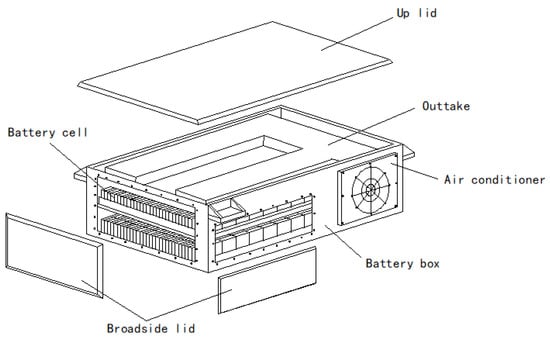
Figure 1.
The original schematic diagram of the power battery system.
After the preliminary design, the original scheme can meet the requirements of providing a stable power supply and various functions for the locomotive. However, this scheme uses air conditioning forced cooling, and the box can only provide the level of IP 56 [23,24] protection. As the power battery system is exposed to the locomotive body, the under-vehicle equipment will be damaged by rain, sand, silt, and debris along the locomotive, and wading will be encountered under extreme conditions. After the cell is formed, each electrode is in a semi-sealed state. If external objects invade, the insulation failure between the cell electrodes will lead to a short circuit, thus causing a fire. Therefore, it is necessary to improve the protection level of the power battery box. At the same time, with the design of this scheme, the overall weight of the system reaches 2470 kg, which is too close to the 2550 kg stipulated in the bearing standard of the locomotive under-frame. Therefore, optimizing the box structure to achieve the purpose of weight loss is inevitable.
3. Power Battery Box Optimization
3.1. Optimization Logic
First of all, after the protection level of the power battery is raised to IP68, the battery module will be wrapped with a metal shell. In that case, the scheme of the air conditioning equipment does not include the conditions for realization; therefore, other kinds of heat dissipation methods must be adopted. According to the locomotive design scheme, the operating ambient temperature of the locomotive is within the range of −25~45 °C, and the operating temperature of the battery selected in this study ranges from −40 °C to 85 °C, the maximum temperature is above 45 °C, and the minimum temperature is below −25 °C. This shows that the battery condition can work normally in the locomotive environment without forced cooling equipment. At the same time, the type of power battery has passed the temperature impact test required in the GB/T31467.3-2015 “Lithium-ion Battery Pack and System for Electric Vehicles, Part 3: Safety Requirements and Test Methods.” Combining the above two points, the power battery pack uses the conditions of natural wind cooling.
Secondly, after using the natural air cooling scheme, the battery cannot be used in a centralized layout, but it should be distributed to ensure that enough batteries can contact the natural airflow. Therefore, the power battery box structure should be optimized for the frame type. In conclusion, the optimize logic diagram is shown in Figure 2.
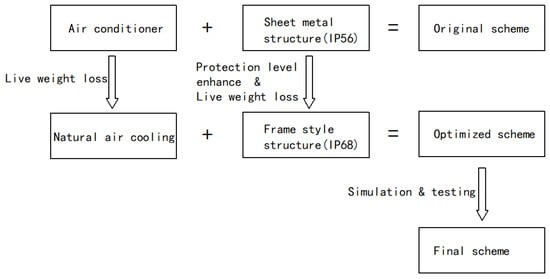
Figure 2.
Optimize logic diagram.
3.2. Design of Two-stage Protective Structure of Power Battery Box
According to the operating environment of the power battery, the battery box should have a protection level of IP68 and a protective structure resistant to external impact. At the same time, without the air conditioning unit, the box structure of natural air cooling should be considered to provide a channel for the circulation of hot and cold air. Therefore, the box design concept of two-level protection should be introduced, namely the separation of the two protection functions. The first protection directly protects the cell, providing a closed environment. The second protection is set in the first protection periphery, providing mechanical support and a physical barrier for the cell, as well as providing the mechanical interface between the battery box and the locomotive body. The gap between the primary and the secondary protection structure provides a cooling duct for the battery pack. Finally, it can improve the protection level of the box while providing an effective heat dissipation mode for the power battery pack.
3.2.1. The First Protection Structure
The first protection structure packages a set of electric cells to form a battery pack with a confined space, whose structural composition is shown in Figure 3.
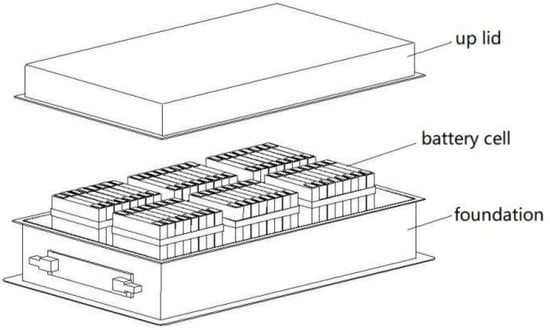
Figure 3.
Composition of the first protection structure.
As shown in Figure 3, the cell is installed and fixed inside the base; there is a heat conduction pad between the core and the base. The heat released by the cell during work can be transferred from the bottom of the battery to the metal shell plate of the battery pack through the heat conduction silicone fat, which can be carried away by the natural wind in the power battery box, and the upper cover and the base are mechanically connected. Meanwhile, the flange plate has a sealing ring, which plays a sealing role after the installation of the upper cover and the base. The base of the first protective structure is made of aluminum sheet metal welding material, and the upper cover is made of aluminum stamping material; the sealing ring is made of (EPDM) [25,26], the end of the first protective structure is equipped with an electrical connector, and the protection level is IP68. Figure 4 shows a schematic diagram of the sealing structure.

Figure 4.
Schematic diagram of the sealing structure.
3.2.2. The Second Protective Structure
The second protection of the power battery carries the weight of the cell, provides a physical protection barrier for the cell, and provides the mechanical interface between the power battery system and the locomotive. The composition of the second protective structure is shown in Figure 5.
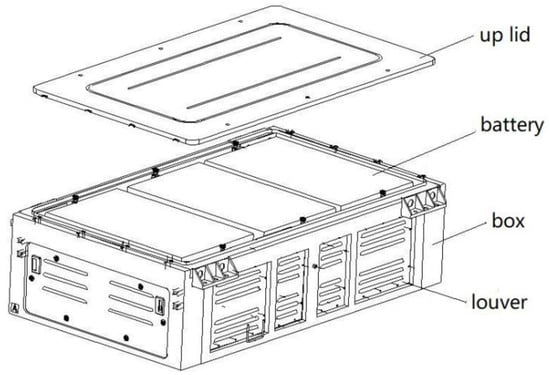
Figure 5.
Composition of the second protective structure.
As shown in Figure 5, six battery packs are arranged in the box in two layers, with three battery packs on each layer. There are shutter vents on all sides of the box, which can provide natural wind for the heat radiation of the battery pack and prevent the rain from splashing onto the battery. There is a drainage hole at the bottom to avoid the water storage phenomenon after the water enters the box under special circumstances. The four top corners are equipped with flange plates for the installation and transportation of the battery box. The box material is Q235 carbon structure steel [27], and the mechanical properties of the materials are shown in Table 1.

Table 1.
Mechanical performance of materials.
The second protection structure design scheme adopts the frame structure type. This frame structure box is utilized with type steel welding to accommodate the overall stress structure of the box, since it is lightweight and exhibits strong bending and torsion resistance, small deformation, and low cost. The structural welding is performed according to the EN15085 standard [28,29]. The composition of the second protection structure is shown in Figure 6.
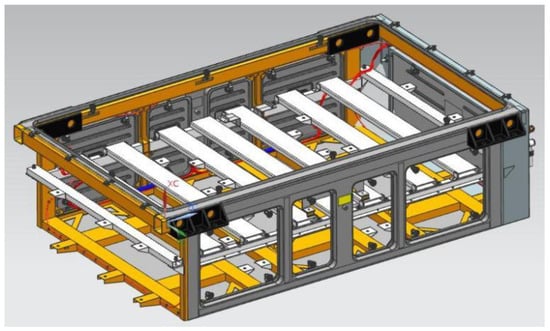
Figure 6.
Composition of the second protection structure.
Combined with the design of the first protection and the second protection structure, the three-dimensional model of the power battery box is obtained, as shown in Figure 7.
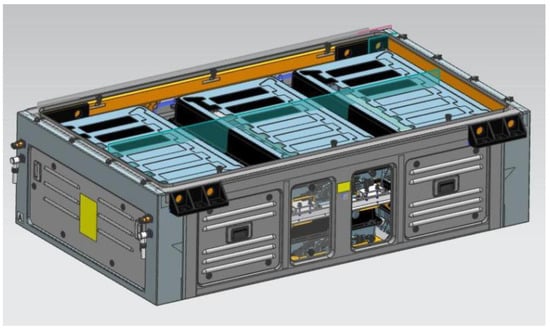
Figure 7.
The 3-D model of the power battery box.
4. Simulation Analysis and Test Verification
After the redesign of the power battery box and the layout of the cell, we obtained the optimized power battery system scheme, but in order to determine whether the optimized scheme meets the real working requirements regarding the box mechanical and cooling performance, the optimized scheme must be judged through simulation analysis and test verification.
4.1. Simulation Analysis of Power Battery Box
The optimized power battery system scheme should meet the operating conditions of the locomotive. Before conducting the physical test, reasonable simulation and verification work of the system should be carried out to determine whether the optimized scheme is feasible. The following details the working environment analysis [30] and simulation verification.
4.1.1. Working Conditions
The stress of a power battery system under normal operation can be summarized into three types: (1) The load in the upper and lower direction, which is mainly produced by the battery weight (with the horizontal surface as the reference); (2) The load on the battery box in the direction of emergency deceleration or acceleration; (3) The transverse load of the locomotive due to the tilt angle of the line profile.
4.1.2. Simulation Conditions
- (1)
- Battery self-load
Six battery packs, with a weight of 220 kg each, are placed inside a single battery pack, and the total weight of the battery pack is 1320 kg. Taking 2.5 times the design margin, the total weight ultimately applied to the battery case is 3300 kg. Taking g = 9.8 N/kg, the required battery self-load force is 32,340 N.
- (2)
- Longitudinal impact load
Assuming that the emergency braking begins at the speed of 50 km/h, and the emergency braking distance is within 40 m, there is the following analysis:
F = M·a = 3300 × 2.395 = 7903.5 N. Thus, the force generated by the vehicle on a single battery case during the braking process is 7903.5 N. Multiply by 2 for the design margin, the required brake longitudinal load force is 15,807 N.
- (3)
- Horizontal impact load
When the locomotive passes through the curve line, the battery box is impacted horizontally by the tilt of the cross-section and the centrifugal force. At present, it is difficult to confirm the prerequisite conditions of transverse impact under the unknown line conditions and turning speed limit, so the braking force F = 15807 N, determined by a longitudinal impact, is used to check the transverse impact load.
4.2. Simulation Results of Mechanical Characteristics
- (1)
- Battery self-load
External load F = 32340 N, and unevenly distributed in the box, the simulation analysis of the model shape is carried out. The shift distribution and the stress distribution diagrams are shown in Figure 8.

Figure 8.
Self-load stress distribution (a) and shift distribution (b) diagram.
- (2)
- Longitudinal impact load
The external load is set to 15,807 N, evenly distributed, the direction is the rail radial direction, and the simulation analysis of model shape is carried out. The longitudinal load stress distribution diagram and the shift distribution map are shown in Figure 9.

Figure 9.
Longitudinal load stress distribution (a) and shift distribution (b) diagram.
- (3)
- Horizontal impact load
The external load is set to 15,807 N, evenly distributed, acting on the long side of each truss, for the simulation analysis of the model shape. The lateral load stress distribution diagram and the lateral displacement distribution map are shown in Figure 10.
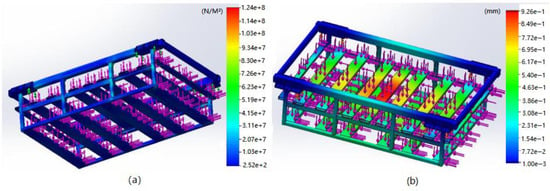
Figure 10.
Lateral load stress distribution (a) and shift distribution (b) diagram.
- (4)
- Modality
For the frame structure, the frequencies and vibration patterns of the first 5-order modes are shown in Table 2.

Table 2.
Mode analysis results of the power battery cabinet.
The mode analysis calculation result shows that the first order natural frequency of the power battery body box is 47.932 Hz, and the vibration type [31,32] is the box body swinging along the forward or backward direction of the locomotive. Figure 11 shows the elastic pattern diagram at the first 5-order natural frequencies.
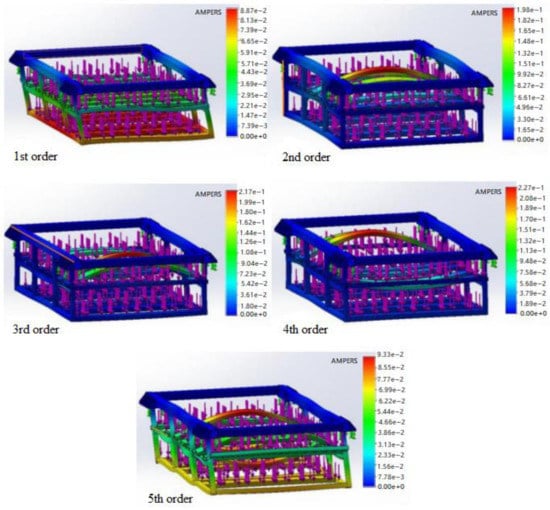
Figure 11.
The top pattern of 5 orders.
Because the first 5-order frequency of the locomotive aluminum alloy car body is in the range of 8~13 Hz, the box structure mode frequency is far away from this range [33]. The mode simulation analysis shows that the box structure has good mechanical properties in this design.
- (5)
- Analysis of fatigue
Based on the above simulation results, we create a new fatigue analysis task and define the S–N curve, which is shown in Figure 12.
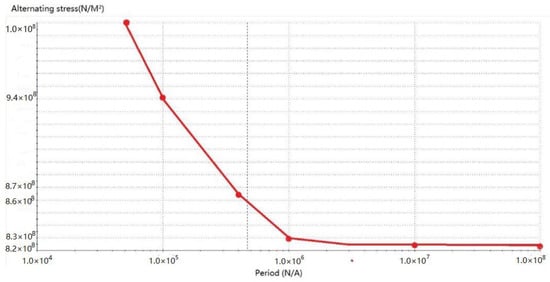
Figure 12.
S-N curve.
The fatigue simulation results of the box model are shown in Figure 13. Among them, Figure 13a shows the damage percentage diagram, Figure 13b is the life cycle diagram, and Figure 13c is the load factor illustration diagram.
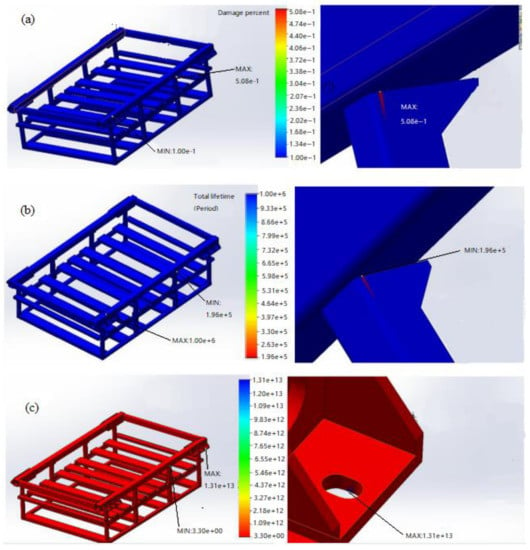
Figure 13.
The fatigue simulation results. (a) Damage percent diagram. (b)Total lifetime diagram. (c) Load factor diagram.
According to the simulation diagram, the frame box first acheives the fatigue phenomenon after 1.0107 vibrations. The summary percentage of structural damage is 0.22%, the minimum load factor is 3.75, and the load factor is greater than 1, which confirms that it will not constitute harmful fatigue.
The results of the above analysis are summarized in Table 3.

Table 3.
Simulation results of the power battery box.
According to the data in the above table, the maximum load stress in all directions of the box is within 235 MPa of the allowable stress of the steel, and there is no harmful deformation. The mode frequency range does not resonate with the car body, the performance is good, the fatigue load factor is greater than 1, and there is no harmful fatigue. The simulation results show that the frame structure is feasible as the secondary protection structure of the power battery box to carry all the various loads generated during the power battery trial period.
The simulation results of the mechanical properties prove that the optimized structural design of the frame power battery box is reasonable, the structure can withstand the various loads generated by the locomotive in operation, and compared with the original scheme, the change in the box frame does not affect the box mechanical performance.
4.3. Thermal Simulation Analysis
According to the above frame structure box, the temperature change of the battery core under the operating environment is simulated, and the natural air cooling effect is analyzed.
The power battery box contains a total of 6 battery packs with a 100 mm wide air intake gap. The average running speed of the locomotive is 20 km/h, and the natural heat exchange coefficient of the battery box is 8 × 10−6 W/(mm2·°C), according to its wind speed. Thermal simulations of the power battery case were performed with ANSYS. Internal heat transfer path of the battery box: cell-module-thermal conductive pad-box-air.
- (1)
- Low-temperature heating condition
The simulation condition of low-temperature heating is shown in Table 4.

Table 4.
Low-temperature heating simulation working condition.
While heating at −30 °C for 1 h, the minimum temperature is −11.8 °C, the temperature rise rate is 18.2 °C/h, and the overall temperature difference of the battery pack is 4.3 °C. All the results meet the design requirements. The temperature change curve is shown in Figure 14.
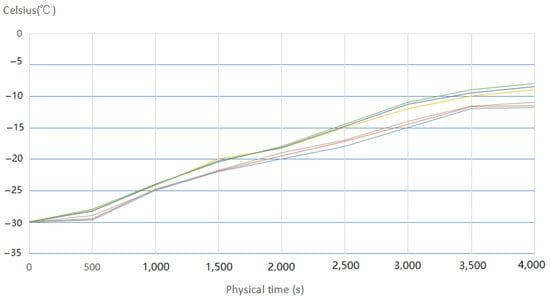
Figure 14.
Temperature variation curve.
- (2)
- High-temperature charging condition
The simulation conditions of high-temperature charging are shown in Table 5.

Table 5.
Simulation condition of high-temperature charging.
While maintaining a 0.3 C charge (80% state of charge) at 45 °C, the highest temperature of the cell at the complete charging time is 51.38 °C, and the overall temperature difference of the battery is 2 °C; this meets the design requirements.
Because the charging rate is low, the battery heat is not obvious. The temperature distribution of the battery pack is relatively uniform, with the highest temperature inside the battery system cell, and the lowest point is at the edge of the battery. The temperature change curve and temperature cloud map are shown in Figure 15 and Figure 16. The red curve is the battery’s highest battery temperature, the purple curve is the average battery temperature, and the blue curve is the battery’s lowest temperature.
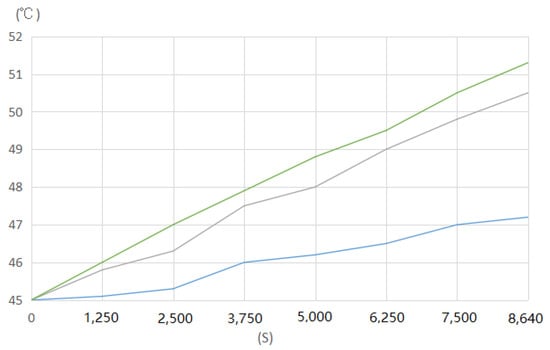
Figure 15.
High-temperature charging condition temperature change curve.
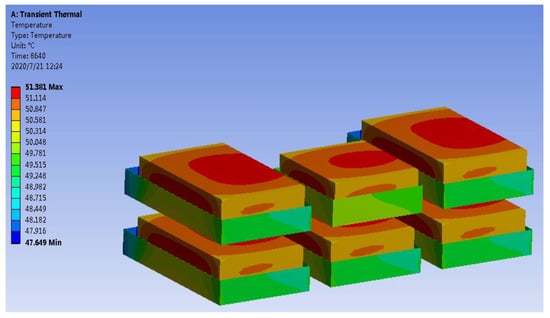
Figure 16.
Temperature cloud diagram.
- (3)
- High-temperature discharge condition
The simulation condition of high-temperature discharge is shown in Table 6.

Table 6.
Low-temperature heating simulation conditions.
In the discharge condition, the battery heat generation is large, but the battery temperature distribution is relatively uniform. The highest temperature appears inside the battery cell, and the lowest point is at the edge of the battery. The green curve is the highest battery temperature, the blue curve is the average battery temperature, and the red curve is the battery’s lowest temperature. According to the strategy of 0.7 C, discharge 1 h at 45 °C, the highest temperature of the cell is 54.384 °C, and the temperature difference is about 3 °C, which meets the design requirements. The temperature change curve and temperature cloud map are shown in Figure 17 and Figure 18. The red curve is the battery’s highest temperature, the green curve is the average battery temperature, and the blue curve is the battery’s lowest temperature.
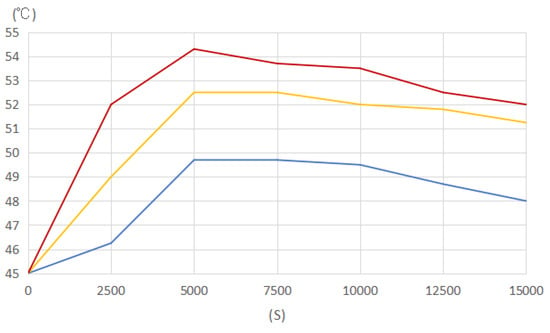
Figure 17.
High-temperature discharge condition temperature change curve. (The red curve is the battery’s highest temperature, the green curve is the average battery temperature, and the blue curve is the battery’s lowest temperature).
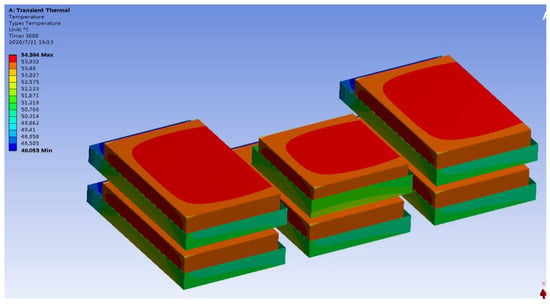
Figure 18.
Temperature cloud map.
According to the simulation outcomes, this design scheme shows good heat management conditions under low-temperature heating conditions, high-temperature charging conditions, and low-temperature discharge conditions, which can provide a good temperature environment for the power battery pack.
The simulation results for the thermal properties prove that the optimized natural air-cooled structure design is reasonable, the shutter structure can provide effective cooling of natural airflow for the power battery pack, and compared with the original scheme, the change in the heat dissipation mode of the power battery box has no harmful effect on the normal operation of the power battery.
4.4. Power Battery Box Test and Verification
The inspection standards used are Q/CRRC J 37.1-2019 (Test Method of Rail Vehicle Energy Storage System, Part 1: Power Battery System) [34] and GB/T21563-2018 (Impact and Vibration Test of Rail Transit Locomotive and Rolling Stock Equipment) [35]. The results are shown in Table 7. And the prototype for the test is shown in Figure 19.

Table 7.
Power battery test item points.
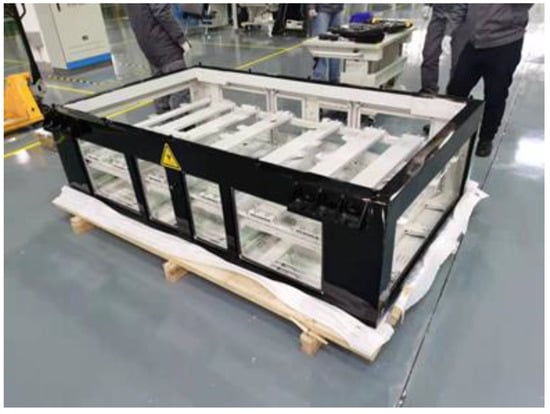
Figure 19.
Structure prototype of the power battery box.
The field test photographs are shown in Figure 20.
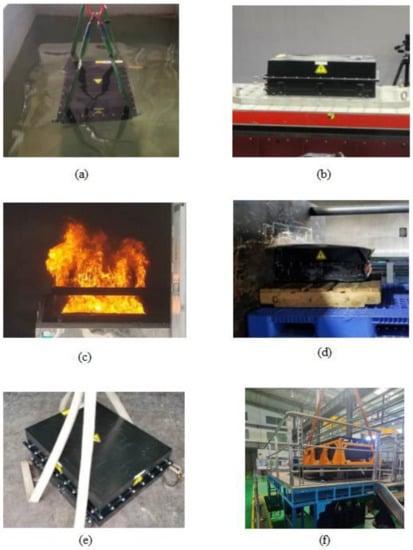
Figure 20.
Test photographs. (a) Seawater immersion. (b) Salt mist. (c) External fire. (d) Squeeze. (e) Simulation collision. (f) Depreciation &Vibration test & Impact test
4.5. Economic Comparison
Through the economic comparative analysis of this design scheme and one-stage protection scheme, it can be observed that the two-stage protection design can simultaneously achieve battery protection, prevent thermal runaway, and reduce the design and maintenance costs. The economic comparison between the two schemes is shown in Table 8.

Table 8.
Economic Comparison for box types.
As can be seen in the above table, the two-stage protective box can save 0.44 m3, reduce the weight of the equipment by 450 kg, reduce the maintenance hours consumed by 2 h per system, and reduce the maintenance costs by CNY 11,700 due to the more lightweight frame structure, all without requiring the use of additional cooling equipment.
5. Discussion
First of all, in the study of the power battery cooling mode, by comparing the working environment temperature range of the locomotive and the working interval of the battery, and referring to the ambient temperature alternating test results for this type of battery, it is confirmed that the natural air-cooled battery cooling mode can be selected for the optimization of this scheme. In the temperature simulation analysis results in Section 4, under the low-temperature heating condition, the overall temperature rise of the battery pack is 4.3 °C, which is greater than the 2.3 °C under the air conditioning heat dissipation scheme. Under the high-temperature charging condition, the overall temperature rise of the battery pack is 2.0 °C, and the temperature value is the same as the temperature rise under the air conditioning cooling scheme. Under the high-temperature discharge condition, the overall temperature rise of the battery pack is 3.0 °C, and the temperature value is greater than 2.1 °C under the air conditioning heat dissipation scheme. At the same time, the temperature rise under the three working conditions is less than the 15 °C stipulated in the JS175-201805 standard. The simulation results show that the cooling effect of the air conditioning cooling scheme is significantly better than that of the natural air cooling scheme in terms of temperature rise performance. However, the temperature increase value of the latter is still less than 15 °C, which is within the safety range specified in the standard; thus, it is feasible to choose the natural air cooling scheme to replace the air conditioning cooling scheme.
Secondly, at present, a frame structure design is widely used in large structural designs, such as locomotive bodies. The power battery box in this study belongs to the vehicle-mounted fixed equipment scheme, which adopts a sheet metal structure under conventional circumstances. However, to solve the contradiction between the high protection level of the power battery box and the use of natural air cooling dissipation, the two-stage protection structure design, based on the frame structure, is innovatively proposed. This design is currently only applicable for the lithium battery equipment in this scheme. If the battery heat generation level is increased, or if other types of battery packs are replaced, further simulation evaluation and test verification of the two-stage protection design are requireded.
Thirdly, in the process of the mechanical performance analysis of the power battery box structure, each part of the frame structure is connected by welding. In the simulation model, each solder point uses the ideal welding effect, and the allowable welding joint stress is 160 MPa. However, in the actual situation, the manual welding quality must not reach the ideal state, and the actual allowable stress of the weld joint must be less than 160 MPa. In this way, the real result of the simulation is not very rigorous. Therefore, the consideration of the weld quality in the frame structure should be more inclined to the test process, as well as the later loading and application process.
Fourthly, in the temperature simulation, the temperature rise rate in the low-temperature heating condition is 18.2 °C/h, and the overall temperature difference of the battery pack is 4.3 °C, which meets the standard requirements. However, the open natural air cooling environment will inevitably reduce the heating efficiency of the battery pack heating diaphragm. In the open environment, the long-time and high-power heating of the battery heating diaphragm will reduce the service life of the heating diaphragm, which cannot be determined in the thermal simulation, and this will also affect the reliability of the power battery system. Therefore, this problem should be tracked and monitored in a timely manner after the power battery is put into normal operation.
6. Conclusions
Based on the original design scheme of the lithium-ion power battery system of a certain type of subway traction locomotive, this paper introduces the optimization process of power battery boxes from the cooling scheme design and structural design standpoint. The following conclusions are achieved.
- (1)
- The optimized scheme raised the protection level of the power battery box from the original IP56 to IP68, and the scheme passed the test verification by meeting the standard Q/CRRC J 37.1-2019. This shows that in the optimization scheme, the aluminum metal shell, as the first level of protection, is reasonable and effective, fulfills the role of the protective cell, and reaches the protection level of IP68.
- (2)
- For the batteries in this study, the natural air cooling scheme can control the overall temperature rise of the battery within the 15 °C stipulated by the standard under low-temperature heating, high-temperature charging and high-temperature discharge conditions; therefore, this scheme is feasible. The air conditioner scheme can be completely substituted by the natural air cooling scheme, with the system weight decreased by 450 kg and a cost savings of CNY 11,700.
- (3)
- Through the design and research of the power battery two-stage protective box, the contradiction between high-level protection needs and natural air cooling needs is solved, and a new design concept for a locomotive power battery system is provided.
Author Contributions
Conceptualization, S.D., J.L., W.L., and K.W.; methodology, S.D., J.L., W.L., and K.W.; software, J.L. and W.L.; validation, S.D., J.L., and K.W.; formal analysis, J.L., Y.T., and K.W.; investigation, J.L., Y.T., S.D., and K.W.; resources, J.L.; data curation, J.L. and S.D.; writing—original draft preparation, J.L., S.D., and K.W.; writing—review and editing, S.D., J.L., and K.W.; visualization, S.D.; supervision, S.D.; project administration, S.D. and J.L.; funding acquisition, S.D. All authors have read and agreed to the published version of the manuscript.
Funding
This research received no external funding.
Acknowledgments
The authors are grateful to the anonymous reviewers for their constructive comments.
Conflicts of Interest
We declare that we have no financial or personal relationships with other people or organizations that could inappropriately influence our work; there is no professional or other personal interest of any nature or kind in any product, service, and/or company that could be construed as influencing the position presented in, or the review of, the entitled manuscript.
References
- The 14th Five-Year Plan for Railway Science and Technology Innovation. Railw. Tech. Superv. 2022, 50, 9–15+20.
- Chatterjee, K. Characteristics and Thermal Behavior Analysis of Lithium-Ion Batteries for Application in Hybrid Locomotives; Northern Illinois University: Chicago, IL, USA, 2022; pp. 51–64. [Google Scholar]
- Kolpakhchyan, P.G.; Evstaf’ev, A.M.; Nikitin, V.V.; Zarifyan, A.A.; Talakhadze, T.Z. Design Features of a Contact-Battery Shunting Electric Locomotive. Russ. Electr. Eng. 2021, 92, 555–560. [Google Scholar] [CrossRef]
- Iden, M.E. Battery Electric Locomotives & Battery Tenders: Operational & Infrastructure Challenges to Widespread Adoption. In Proceedings of the ASME/IEEE Joint Rail Conference, Online, 20–21 April 2021; American Society of Mechanical Engineers: New York, NY, USA, 2021; Volume 84775, p. V001T07A003. [Google Scholar]
- Wongthong, Y.; Rattanapanyalert, T.; Supopat, T.; Techawatcharapaikul, C. A Design of Energy Storage System for Electric Locomotive. In Proceedings of the 2021 9th International Electrical Engineering Congress, Pattaya, Thailand, 10–12 March 2021; IEEE: New York, NY, USA, 2021; pp. 149–152. [Google Scholar]
- Wu, J.; Ji, Q.; Zhang, C.; Zhu, Z.; Zhao, B.; Yin, Z. Design and Modeling of Diesel-Electric Hybrid Shunting Locomotive. In The Proceedings of the 9th Frontier Academic Forum of Electrical Engineering; Springer: Singapore, 2021; pp. 655–665. [Google Scholar]
- An, Y.; Wang, X.; Dou, N.; Wu, Z. Strength analysis of the lightweight-designed power battery boxes in electric vehicle. In Proceedings of the 2022 7th International Conference on Green Materials and Environmental Engineering, Changsha, China, 16–17 January 2022; pp. 147–153. [Google Scholar]
- Weigao, Q.; Zhanxi, Z.; Dong, L.; Lei, Y. Study on Side Collision of Battery Boxes Based on HyperWorks. J. Phy. Conf. Series 2021, 2137, 012012. [Google Scholar]
- Ding, Q.; Wang, J.; Liu, G.; Yao, B.; Jiang, G.; Du, Q. Research on Safety Design of Protection Box for Emergency Standby Power Supply System of High Speed EMU. Chin. Battery Ind. 2019, 23, 44–49. [Google Scholar]
- Peng, C.; Wang, P.; He, G. Research on Safety Design Technology of High-power Lithium Ion Traction Battery System for Locomotive and EMU. Electr. Drive Locomot. 2020, 5, 123–127. [Google Scholar] [CrossRef]
- Zhang, X.; Zhou, F.; Feng, Q.; He, J. Design of Carbon Fiber Box. Shanghai Automob. 2014, 9, 60–62. [Google Scholar]
- Li, J.; Tian, H.; Wu, P. Analysis of random vibration of power battery box in electric vehicles. In Proceedings of the 2014 IEEE Conference and Expo Transportation Electrification Asia-Pacific, Beijing, China, 31 August 2014–3 September 2014; IEEE: New York, NY, USA, 2014; pp. 1–5. [Google Scholar]
- Chen, Q.S.; Zhao, H.; Kong, L.X.; Chen, K.W. Research on Battery Box Lightweight Based on Material Replacement. In Proceedings of the 2017 5th International Conference on Mechatronics, Materials, Chemistry and Computer Engineering, Chong Qing, China, July 24–25; Atlantis Press: Paris, France, 2017; pp. 346–358. [Google Scholar]
- Meng, Y.; Gao, X.; Ye, D. Optimal Design of HXN6 Hybrid Shunting Locomotive Power Battery Group Structure. Railw. Locomot. Car 2021, 41, 99–104. [Google Scholar]
- Liu, B.; Kang, M.; Xing, T. Hybrid shunting locomotive design exported to German. Railw. Qual. Control. 2019, 47, 43–47+59. [Google Scholar]
- Xie, J.; Liu, L. Electrical system design of a certain hybrid electric locomotive. Technol. Mark. 2021, 28, 15–18. [Google Scholar]
- Hu, L. Analysis of the development route of thermal support system for locomotive power battery. Technol. Mark. 2020, 27, 49–50+52. [Google Scholar]
- Taguchi, Y.; Kadowaki, S.; Yoshikawa, G.; Hatakeda, K.; Kaneko, T. Control method for cooling fans inside traction battery boxes installed in battery powered EMU based on thermal network model. Electr. Eng. Japn. 2021, 2, 23310. [Google Scholar] [CrossRef]
- Yue, Q.L.; He, C.X.; Wu, M.C.; Xu, J.B.; Zhao, T.S. Pack-level modeling of a liquid cooling system for power batteries in electric vehicles. Int. J. Heat Mass Transf. 2022, 192, 122946. [Google Scholar] [CrossRef]
- Zhao, J. Research on Thermal Management System of Electric Vehicle Power Battery Pack. Acad. J. Eng. Technol. Sci. 2020, 34, 62–74. [Google Scholar]
- Wenwei, W.; Cheng, L.; Peng, T.; Chengjun, Z. Thermal characteristic analysis of power lithium-ion battery system for electric vehicle. In Proceedings of the 2012 Third International Conference on Digital Manufacturing & Automation, Guilin, China, 31 July 2012–2 August 2012; IEEE: New York, NY, USA, 2012; pp. 967–971. [Google Scholar]
- Xiang, L.; Cui, J. Simulation analysis of air cooling for vehicle power battery. J. Phys. Conf. Ser. 2018, 1064, 012007. [Google Scholar] [CrossRef]
- GB 4208-2008; Degrees of Protection Provided by Enclosure (IP code). Standards Press of China: Beijing, China, 2008. Available online: https://www.antpedia.com/standard/5639827-1.html (accessed on 6 October 2022).
- Wandong, X. Research and Application of the New Energy Vehicle Power System IP68 Air Tightness Detection Method; East China Jiaotong University: Huichang, China, 2019. [Google Scholar]
- Zhang, G.; Zhou, X.; Liang, K.; Guo, B.; Li, X.; Wang, Z.; Zhang, L. Mechanically robust and recyclable EPDM rubber composites by a green cross-linking strategy. ACS Sustain. Chem. Eng. 2019, 7, 11712–11720. [Google Scholar] [CrossRef]
- Wang, Z.N.; Shen, S.L.; Zhou, A.N.; Xu, Y.S. Experimental evaluation of aging characteristics of EPDM as a sealant for undersea shield tunnels. J. Mater. Civ. Eng. 2020, 32, 04020182. [Google Scholar] [CrossRef]
- Gang, S.; Shihao, W.; Xuesen, C.; Chengxiao, R. Post-fire mechanical properties of base metal and welds of Q235 steel. J. Constr. Steel Res. 2021, 183, 106767. [Google Scholar]
- EN15085: 2020; Railway Applications—Welding of Railway Vehicles and Components—Part 2: Requirements for Welding Manufacturer. Estonian Centre for Standardisation and Accreditation: Tallin, Estonia, 2020. Available online: https://www.evs.ee/en/evs-en-15085-2-2020 (accessed on 6 October 2022).
- Xu, Y.; Zhang, Y.; Liu, B. Key elements and common problems in EN 15085 welding system running. Electr. Weld. Mach. 2020, 50, 132–135. [Google Scholar]
- Zhao, C.; Guo, C. Type HXN3B (4400 HP) AC transmission shunting diesel locomotive battery box design. Sci. Technol. Vis. 2017, 5, 2095–2457. [Google Scholar]
- Wang, K.; Pan, H.Y.; Zhang, T.J.; Wang, H.T. Experimental study on the radial vibration characteristics of a coal briquette in each stage of its life cycle under the action of CO2 gas explosion. Fuel 2022, 320, 123922. [Google Scholar] [CrossRef]
- Wang, K.; Pan, H.; Zhang, T.J. Experimental Study of Prefabricated Crack Propagation in Coal Briquettes under the Action of a CO2 Gas Explosion. ACS Omega 2021, 6, 24462–24472. [Google Scholar] [CrossRef]
- Zheng, T. The Finite Element Analysis and Structure Optimize of Railway Vehicle Battery Box against Shock Vibration; Jilin University: Jilin, China, 2015. [Google Scholar]
- Q/CRRC J 37.1-2019; Test Methods for Onboard Energy Storage System of Railway Transportation Equipment—Part 1: Power Battery System. ITS China: Tianjin, China, 2019.
- GB/T21563-2018; Railway Applications-Rolling Stock Equipment-SHOCK and Vibration Tests. National Railway Administration of People’s Republic of China: Beijing, China, 2018.
Publisher’s Note: MDPI stays neutral with regard to jurisdictional claims in published maps and institutional affiliations. |
© 2022 by the authors. Licensee MDPI, Basel, Switzerland. This article is an open access article distributed under the terms and conditions of the Creative Commons Attribution (CC BY) license (https://creativecommons.org/licenses/by/4.0/).